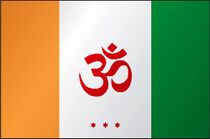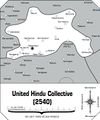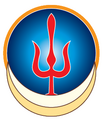United Hindu Collective
| United Hindu Collective | |
|---|---|
| State Profile | |
| Founding Year | mid-2200s |
| Dissolution year: | 2540 |
| Capital world: | Basantapur[1] |
| Controlled system(s): | 17[1] |
| Government | |
| Head of State | Maharaja |
| Military | |
| Army | Messengers of Shiva |
The United Hindu Collective was a minor nation of the Inner Sphere and existed for almost three centuries (from the mid-2200s until 2540) before eventually joining the Federated Suns. The UHC was notable for prospering as a democratic and peaceful society in an age of war and increasing neo-feudalism.[2] Most notably, the UHC was one of only two participants in the Ares Convention conference to refuse to sign the resulting accords (the other state to refuse was the Taurian Concordat). The UHC warned that, rather than reducing conflict, the conventions would legitimize warfare as a way to settle disputes, which turned out to be exactly what occurred.[3]
Contents
History[edit]
The Collective was founded by settlers from Southeast Asia, especially India, during the first Terran Exodus. Wary of staying too close to Terra, the founders explored rimwards and eventually discovered the hospitable "garden worlds" of Basantapur, Panpour and As Samik. Initially close ties to Terran India loosened over time due to the different needs, growing economic strength of the UHC and the sheer distances involved. In 2315 the Collective officially severed its ties with India, instead forming a strong economic partnership with its direct neighbor, the Federated Suns. The UHC's strong industrial and agricultural base helped supply the Suns' outer regions in return for trade benefits and deterrent against the other neighbor, the Taurian Concordat.[2]
Basantapur Treaty[edit]
The UHC prospered and expanded to seventeen worlds by 2534, remaining politically neutral and staying out of the wars that raged across the Inner Sphere. When the Davion Civil War ended in 2540, First Prince Alexander Davion suggested even closer ties between the two nations. After a popular vote in the UHC showed enthusiastic support for the idea, the First Prince and Maharaja Sadhvi Garg signed the Basantapur Treaty in 2540, making the Collective a semi-autonomous member of the Suns. The union proved mutually beneficial, and political and economic cooperation continued to grow until by the start of the First Succession War the former UHC worlds were fully integrated into the Federated Suns.[2]
Government and Society[edit]
The Collective was a true federal democracy with a bicameral congress and a directly elected president who bore the title of Maharaja. Its founding charter guaranteed full equality for all citizens. These strong democratic traditions survived into modern times where many former Collective planets still feature democratic local governments. The predominant ethnicity were Hindu Indians, however other groups such as Sikhs, Christians, Muslims and Jain were also part of the UHC. The union with the Federated Suns led to an increase in ethnic and religious diversity that in some cases led to the renaming of entire worlds such as Jodipur becoming Neukirchen.[2]
Military[edit]
The UHC featured a strong defensive army for its size, with one full mechanized regiment on each member world. In 2480, the acquisition of obsolete AFFS equipment allowed the creation of a mixed BattleMech/Aerospace regiment dubbed the Messengers of Shiva. This unit rotated through the Collective as rapid response force. Its only major engagement was in 2535 when the Varnay faction of the Davion Civil War passed through the region raiding UHC worlds. The Messengers of Shiva engaged and defeated the invaders on Jodipur, humiliating their better-equipped opponents due to superior training and tactics. After the Collective officially joined the Federated Suns, the Messengers were absorbed intact into the AFFS to eventually become the Islamabad Crucis March Militia.[2] [4]
The Collective also featured a navy, though it did not operate any WarShips. Several of its JumpShips survived for centuries in Davion service, with one ship, the Rama Sita even reaching Huntress while partaking in Operation BULLDOG.[2]
Gallery[edit]
Notes[edit]
The description of the United Hindu Collective in Era Digest: Age of War includes three non-map images - a flag, and two insignia. The provenance of the two insignia was confirmed on the official forums:
| “ | The Flag is the flag of the UHC. The sword-in-disc is the military insignia. The trident-over-crescent-moon is the Messengers of Shiva. | ” |
| — Adrian Gideon, CGL Art Direction, Design & Production, 06 June 2011 | ||






